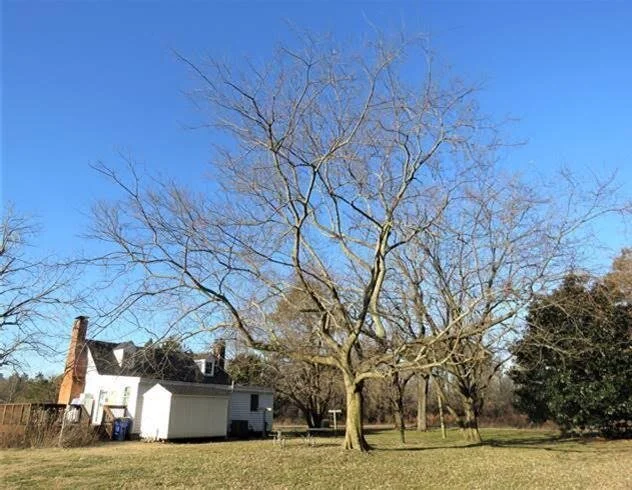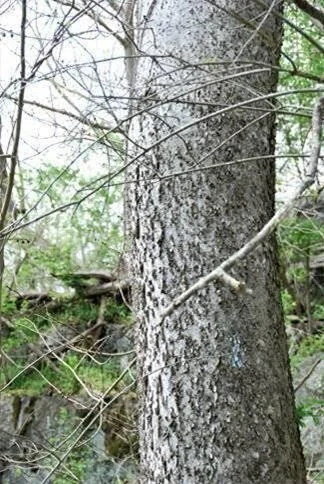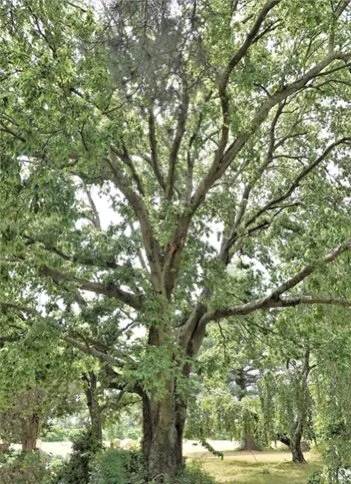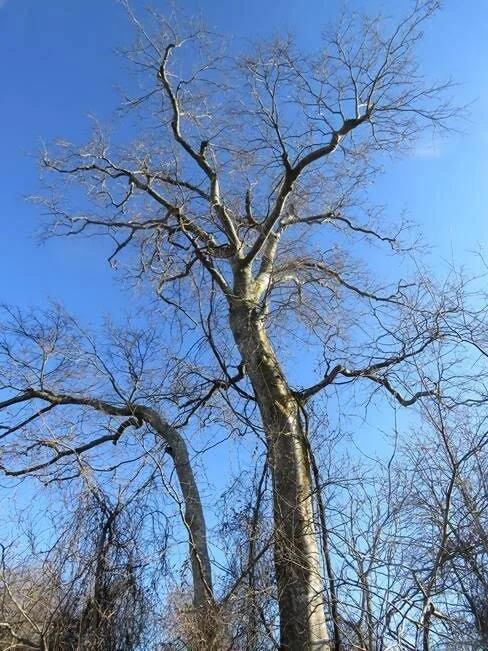Plant of the Month February 2021: Common Hackberry
Common Hackberry, Celtis occidentalis
Also known as Sugarberry, Beaverwood,
By Betsy Washington
Common Hackberry in winter at Belle Isle State Park, next to Camp Store
Photo by Betsy Washington
The Common Hackberry is one of our most adaptable native shade trees and is also among the best trees to plant for wildlife. The trunk of hackberries has smooth gray bark covered with distinctive warts, bumps, and corky ridges and is one of its most recognizable features, especially in winter. They have a graceful upright habit with arching limbs and fine-textured, pendulous branch tips, often tinged red in winter. This rugged tree is full of ornamental character sometimes with picturesque twisting branches and small twiggy, tangled growths at the tips of twigs, known as ‘witches brooms’.
The 3 – 4” long rough-textured leaves alternate along the stems and are oval with fine teeth along the margins, and, like their cousins the elms, taper to a long point and have an asymmetrical or lopsided base. They turn a handsome yellow in fall.
The distinctive gray bark of the Common Hackberry with warts and ridges
Photo by Betsy Washington, Belle Isle State Park
The insignificant greenish-yellow flowers bloom in spring with both sexes on the same tree and are wind pollinated. The prolific fruits are small, leathery, pea-sized drupes or “sugar” berries that turn orange-red as they ripen in late summer and fall, then turn a dark purplish-black color and persist through much of the winter. The drupes have a hard leathery covering with a single hard pit, but the flesh is thin, sweet and edible, reminiscent of a raisin. Songbirds relish the fruit and eat the entire drupe, then excrete the hard seeds thereby dispersing them. The sugary berries are especially important food for migrating songbirds in fall and again in spring. Flocks of hungry cedar waxwings, robins and other migrants often descend on Hackberry trees and devour the berries. Residents such as yellow-bellied sapsuckers, wild turkeys, and mockingbirds also depend on the persistent sweet berries when winter food is limited. Squirrels as well as other mammals and even an occasional turtle also rely on the fruit.
Hackberry’s wildlife value does not stop with vertebrates. They are also the host for caterpillars of some of our showiest and most sought-after butterflies including: the adorable Snout, the curious Question Mark and the Comma, the early Mourning Cloak, and the sometimes ‘friendly’ Tawny and Hackberry Emperors butterflies. These last two are well known to often land on amazed humans, apparently attracted to the minerals in our sweat and on our skin or clothing.
A majestic Common Hackberry in summer finery in Westmoreland County
Photo by Betsy Washington
Hackberries are not only beautiful, but extremely adaptable trees. They attain their best growth and are most frequently found in moist bottomlands, floodplain forests, and alluvial, nutrient-rich soils where they grow quickly and achieve their best growth, often reaching 60 – 80’ in height. They transplant readily into clay or sandy soils and prefer sunny sites. They are also tough and tolerant of challenging conditions, including both high pH and acidic soils, both drought and short-term flooding, and can also be found on dry rocky ridgetops, on calcareous soils, and in hedgerows along old fields. Tolerant of air pollution and salt spray, they make outstanding urban or street trees. In challenging sites, hackberries are more typically mid-sized trees, reaching only 30 – 50’ in height.
Hackberries have no serious pests or diseases although tiny (Eriophid) mites and a fungus often cause ‘witches broom’, a distinctive tangle of twiggy branchlets at the end of branch tips. These are typically only a superficial blemish, adding character and winter interest to the silhouette. Common Hackberries have been reported to be “allelopathic”, releasing chemicals that discourage some plants from growing under them. A great solution is to simply allow the natural leaf litter and native plants that survive there to make a living groundcover beneath the tree. This has the crucial benefit of allowing the over-wintering butterfly cocoons (chrysalis) and other beneficial wildlife (e.g. insects and amphibians) to safely overwinter in the fallen leaves to delight you again the following year.
While I love these trees, I must add that their abundant fruit so favored by our feathered friends, can cause a mess when a hackberry is planted over a driveway where your car is parked, as birds excrete the drupes. So, plant your hackberries in a natural area where you can enjoy the parade of wildlife but not have to clean up after them! The fallen berries will still be relished by wildlife.
Common Hackberries will make a splendid addition to your garden as a shade tree, elegant in habit, but tough as nails in constitution. But best of all, Hackberries are superlative wildlife trees, and this is reason enough to plant one in your yard. If you are lucky enough to have an extra sapling in your yard, call me!
The winter branching of the Common Hackberry
Photo by Betsy Washington, Belle Isle Camp Store
Friendly Hackberry Emperor Greets A Visitor at George Washington’s Birthplace, Westmoreland County
Photo by Jeff Wright





